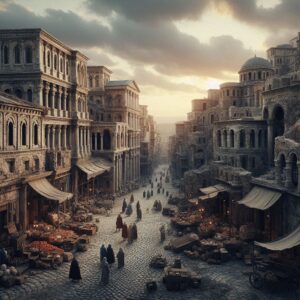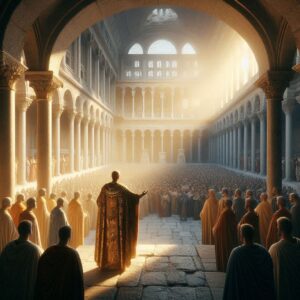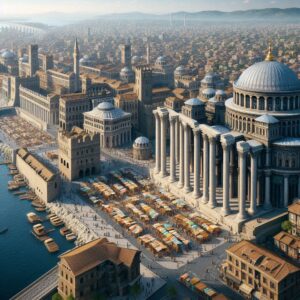History is filled with moments of profound transformation—occasions when the old is remade into something vibrant and new. One such pivotal moment occurred on May 11, 330 AD, when Emperor Constantine the Great dedicated the newly rebuilt city of Byzantium as “New Rome.” In choosing to designate this city as the capital of the Eastern Roman Empire, Constantine not only reimagined the center of power for a vast empire but also set in motion a legacy of cultural, political, and religious evolution that lasted for centuries. The transformation of Byzantium into New Rome stands as a testament to the power of reinvention—a lesson that can resonate deeply in our personal lives today.
In this blog, we will explore the significance of this historical event, examine its long-lasting impact on the world, and draw inspirational parallels to our own lives. Whether you are seeking to overcome personal setbacks, reinvent your career, or rejuvenate your inner spirit, the story of New Rome offers enduring lessons on the importance of reconstructing one’s foundation, embracing change, and forging a future that is uniquely your own.
## I. The Historical Backdrop: From Byzantium to New Rome
### A. Byzantium and Its Pre-Constantinian Foundations
Before Constantine’s ambitious vision took shape, Byzantium was an already ancient and resilient city with roots stretching deep into classical antiquity. Positioned strategically on the Bosporus Strait, Byzantium had long functioned as a crossroads between East and West, a gateway to trade and cultural exchange. Yet, by the beginning of the 4th century, the Roman Empire was in crisis, with its splintered resources and political decay leading to instability across its vast territories.
Constantinople’s location was not chosen at random. As Byzantium lay at the confluence of important trade routes, it offered a natural bulwark against external invasions and an ideal spot for administrating an empire that had grown unwieldy in its traditional western capital. In 330 AD, following years of extensive rebuilding and fortification, Emperor Constantine announced the city’s rebirth by renaming it “Nova Roma” (New Rome). This new designation was more than a symbolic act— it was a radical reordering of the empire’s power structure, a bold move toward a future rooted in innovation and adaptation.
### B. A City Reborn: The Vision of Constantine
Constantine’s decision to shift the empire’s center of gravity was driven by practical concerns and visionary ideals alike. Recognizing that the old ways of administration and governance were faltering, he set about creating a new urban masterpiece that would be both the nexus of political power and the embodiment of renewed cultural values. New Rome was designed with impressive architecture, innovative urban planning, and fortified defenses, all intended to signal the beginning of a new era.
The transformation of Byzantium into New Rome can be seen as a microcosm of how societies—and indeed individuals—can break free from stagnation. With deliberate planning, bold investments, and a willingness to reinvent the established order, Constantine laid the foundation for what would become the Byzantine Empire—a vibrant civilization that preserved classical knowledge and ultimately influenced the Renaissance and modern Western thought.
## II. The Symbolism of New Rome: A Beacon of Transformation
### A. Embracing the Past, Yet Breaking Free
At first glance, the dedication of New Rome is a story of continuity. It celebrated a city with an ancient legacy and re-appointed it as the heart of a new political order. Yet, at its core, it was equally about moving forward. Constantine didn’t simply restore Byzantium—he reimagined it. By constructing new public buildings, erecting monumental statues, and redefining urban spaces, he transformed the old into a dynamic new center of power.
This symbolic reinvention is a powerful reminder that our personal and professional lives, too, can benefit from a careful balance between honoring the past and forging a future unencumbered by outdated models. Sometimes, the idea of reinvention demands that we dismantle parts of our old self or old habits while preserving their valued kernels, repurposing them as the building blocks for a new beginning.
### B. A Vision for the Future
By declaring Byzantium as “New Rome,” Constantine encapsulated the desire to create a future that was distinct from the declines of prior eras. He understood that the seeds of catastrophe sometimes lie in rigidity and adherence to outworn patterns. In contrast, transformation requires openness, flexibility, and the courage to dream bigger than the constraints of the present.
New Rome symbolized renewal—an oasis of hope during troubled times. It became a melting pot of cultures, a thriving economic center, and ultimately, a beacon of Christian civilization. Its legacy reminds us that by embracing visionary change, even the most troubled circumstances can be transformed into opportunities for growth and long-term prosperity.
## III. Applying the Lessons of New Rome to Modern Life
### A. The Relevance of Reinvention Today
In our contemporary lives, we often grapple with challenges that feel insurmountable. Whether it’s a career plateau, personal setbacks, or the burden of outdated beliefs, many of us experience a sense of stagnation. Yet, the historical transformation of Byzantium into New Rome teaches us that reinvention is always possible. By questioning the status quo and daring to construct a more enlightened version of ourselves, we can redefine our scope and chart a new course towards fulfillment.
For instance, someone feeling trapped in a monotonous job might draw inspiration from Constantine’s bold decision to rebuild a decaying city. They can understand that breaking away from outdated systems doesn’t mean discarding all that came before—it means finding the right elements to carry forward while erecting new structures that reflect one’s evolving values and aspirations.
### B. Rebuilding Your Foundations
The process of rebuilding one’s life is neither quick nor easy. It requires introspection, planning, and the audacity to take risks. Much like a city’s architecture is meticulously planned, every individual has the capacity to re-envision the framework of their existence. Here are several key steps inspired by the New Rome transformation:
- **Assess Your Foundations:**
Identify the habits, beliefs, or routines that no longer serve you. Just as Byzantium had remnants of its ancient past that needed renovation, your current practices might benefit from modernization. Reflect on what is working, what hinders you, and what can be salvaged for your new beginning.
- **Create a Vision:**
Have a clear, compelling vision of the future. Constantine’s vision was not merely about restoring a city; it was about sculpting a new center of power that could lead an empire into the future. Similarly, define what success, happiness, and personal growth look like for you. Write it down as a manifesto to guide your transformative journey.
- **Plan Thoughtfully:**
Transformation is an incremental process that demands structured planning and persistent effort. Develop a step-by-step strategy to reach your vision. Set short-term and long-term goals, ensuring that each action builds upon the previous one, much like the careful urban planning that created a metropolis from ruins.
- **Embrace Change with Courage:**
A significant transformation always involves stepping into the unknown. Embrace the possibilities that arise when you dare to challenge the familiar. Whether it’s learning new skills, pursuing different career paths, or cultivating fresh relationships, let change be the engine that drives your reinvention.
- **Cultivate Resilience:**
Rebuilding a foundation is never without setbacks. Reflect on the resilience that allowed New Rome to thrive despite periods of instability. Build your mental and emotional strength by celebrating small victories, learning from failures, and maintaining the determination to press forward regardless of obstacles.
### C. The Role of Innovation in Personal Growth
Innovation isn’t solely the domain of empires and technological breakthroughs—it is the heartbeat of personal evolution. The rebuilding of Byzantium into New Rome was not just an act of physical reconstruction but also an ideological renaissance. In today’s world, each of us can embody that spirit by continually seeking new ways to approach our challenges.
For example, consider how embracing modern technologies, new learning paths, or even creative self-expression can act as catalysts for transformation. Much like the architectural marvels of New Rome were a blend of ancient wisdom and innovative design, your personal growth can be driven by merging traditional values with contemporary insights.
## IV. Real-Life Stories of Reinvention
To understand the practical impact of historical transformation on individual lives, let’s look at some modern examples:
### A. A Career Reinvented
Imagine an individual named Sarah who worked in a stagnant corporate environment. Over time, the routine and rigidity of her career left her feeling unfulfilled. Inspired by stories of historical reinvention, Sarah gathered the courage to pursue her passion for graphic design. She enrolled in online courses, networked with creative professionals, and began freelancing. Though the transition was fraught with uncertainty, Sarah’s persistence led her to build a successful career that now reflects her true passions. Sarah’s journey mirrors the transformation of Byzantium—she recognized the need for change, dismantled outdated habits, and rebuilt her professional self on a foundation of new ideas and creativity.
### B. Personal Transformation Through Reinvention
Sometimes, the most significant transformations occur within. Consider James, who had long struggled with self-doubt and a fear of failure. Inspired by the historical narrative of New Rome—where an ancient city gave way to new hope—James embarked on a journey of personal development. He started by identifying habits that kept him from pursuing his dreams, such as procrastination and negative self-talk, and gradually replaced them with positive routines like morning meditation, journaling, and regular exercise. Over time, James not only overcame his self-imposed limitations but also discovered a renewed sense of purpose. His personal evolution is a testament to the transformative power of bold reinvention.
## V. Crafting Your Own Manifesto for Transformation
History teaches us that monumental changes are built on clear visions and unwavering commitment. To help you embark on your own journey of transformation, consider creating a personal manifesto. Here’s how to get started:
### 1. **Reflect Deeply on Your Current Foundations**
Begin by assessing your life. Identify the parts that work well and the parts that are holding you back. This can involve both internal beliefs and external circumstances. Write down your thoughts—treat this as the blueprint of your “old city” that needs renovation.
### 2. **Envision the Future You Desire**
With your current foundations laid bare, paint a picture of the future you want to create. What does success look like? What habits, skills, or relationships do you aspire to cultivate? This vision should be bold yet achievable—ambitious enough to challenge you but grounded in reality.
### 3. **Set Clear, Actionable Goals**
Break your vision down into specific goals. Each goal is like a brick that you will use to rebuild your life. Create a timeline, outline necessary steps, and be prepared to adjust your plans as you grow. Remember, the process of transformation is not linear, and flexibility is key.
### 4. **Commit to Lifelong Learning and Adaptation**
Transformation is an ongoing journey. Celebrate your successes, learn from setbacks, and remain open to new opportunities. Just as New Rome evolved over centuries, your personal reinvention is a continuous process—a dynamic project that requires evolution and adaptation as circumstances change.
### 5. **Find Support and Inspiration**
No great transformation happens in isolation. Connect with mentors, peers, or communities that share your vision for change. Their insights, encouragement, and experiences can serve as valuable guides as you navigate your transition. Collaboration and support provide strength and accountability, making your journey more sustainable and inspiring.
## VI. Embracing the Boldness of Change
The dedication of New Rome on May 11, 330 AD, is not merely an ancient footnote—it is a timeless symbol of radical transformation and the unyielding spirit of reinvention. When Emperor Constantine chose to rebuild a city, he was not abandoning the past but thoughtfully crafting a future that honored what was while boldly pursuing what could be. This act of visionary courage resonates with anyone who has ever felt limited by outdated systems, both externally and within themselves.
In the modern context, many of us are faced with decisions about whether to accept the status quo or to strive for something greater. Whether confronting a career crisis, personal challenges, or simple stagnation, the decision to embrace change can redefine our entire trajectory. Much like the transformation of Byzantium, each personal act of reinvention is a deliberate, courageous step toward building an enduring legacy—one that reflects our creative potential, strengths, and aspirations.
This historical lesson calls us to examine our lives with both honesty and ambition. It asks us: What parts of our own “city”—our habits, mindsets, and routines—are in need of renovation? And what vision of a renewed self lies just beyond the horizon of our current perception?
## VII. A Call to Rebuild: Finding Your Inner New Rome
As the sun rose over the ancient city that would become New Rome, a new era was born—one defined by hope, renewal, and transformative possibility. Today, we stand at a similar crossroads. The challenges we face may differ in context, but the fundamental human urge to overcome, rebuild, and reinvent remains universal.
Reflect on your own life and consider the transformative power inherent in every decision. Whether you are looking to alter your career path, mend personal relationships, or simply reignite your passion for life, let the story of New Rome inspire you to make bold choices. Embrace the truth that transformation is not about erasing who you were; it’s about integrating the wisdom of the past while paving the way for a future that is fully, unapologetically yours.
Today is more than just a date on the calendar. It is an opportunity—a call to reconstruct the metaphorical city within, brick by brick, habit by habit, dream by dream. Allow this historical legacy to serve as a reminder that every ending is also a new beginning. Use the spirit of reinvention that defined New Rome to take decisive action in your life and build a future that reflects your highest aspirations.
## VIII. Conclusion: Your Transformation Starts Now
The dedication of Constantinople and its rebirth as New Rome is a potent symbol of transformation. It reminds us that even in the face of decay and uncertainty, there is always the possibility of reinvention. History shows that moments of radical change are not shunned—they are celebrated as the starting points of new eras.
As you move forward, take inspiration from this magnificent chapter of history. Revisit your own foundations, craft your personalized manifesto for change, and step boldly into your future. The process of transformation may be challenging, but just as Constantine’s vision transformed an ancient city into a beacon of hope and progress, so too can your efforts lead to a remarkable, lasting renewal.
Embrace the courage to rebuild. Embrace the power to redefine. And remember, every brick you lay in the construction of your new self is a testament to the timeless spirit of reinvention—a spirit that has reshaped empires and, with it, can reshape your life.
Your inner New Rome awaits. Let today be the day you begin your transformation. Embrace change, harness resilience, and step confidently into the future you are destined to create.
By drawing inspiration from one of history’s most monumental acts of reinvention, you have the tools to break free from constraints, recalibrate your mindset, and build a life that’s not only successful but also deeply fulfilling. Let the legacy of May 11, 330 AD, serve as your call to action—to liberate your potential, rebuild your foundations, and rise anew, just as New Rome did nearly 1700 years ago.

